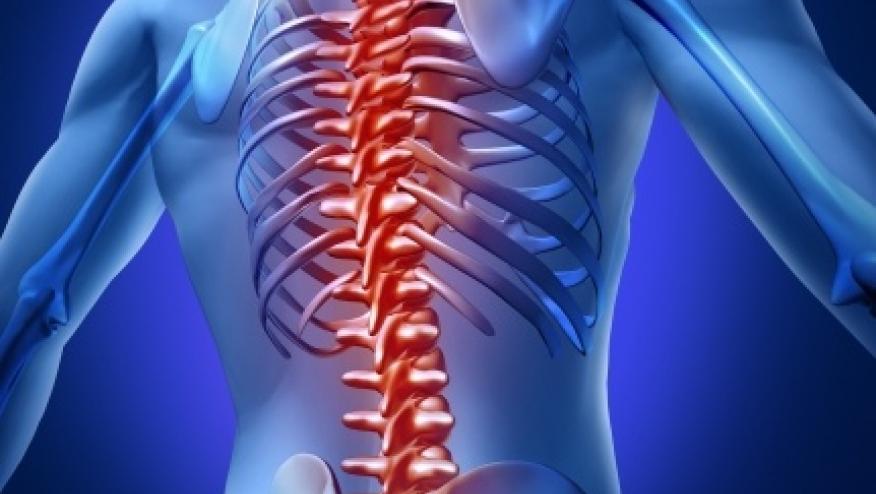A Rule of Five Spots Spine Disease Save

A combined rule of five -- the presence of at least five fatty lesions/erosions in the sacroiliac (SI) joint, at least five fatty lesions in the spine, or at least five spinal inflammatory lesions on magnetic resonance imaging (MRI) -- is highly specific for axial spondyloarthritis in patients with chronic back pain.
Investigators led by Desiree van der Heijde, MD, PhD, Leiden University Medical Center in the Netherlands, found specificity for axial spondyloarthritis to be >95% when applying the cut-off of five or more inflammatory lesions and five or more fatty lesions.
"In our study we have shown that reasonable and applicable cut-offs can be defined for inflammatory and fatty lesions on MRI-spine when specificity (>95%) for axial spondyloarthritis is the main aim," they wrote online in Annals of the Rheumatic Diseases.
"We found the rules '≥five fatty lesions and/or erosions' on MRI-SI, as well as '≥five spinal inflammatory lesions' and '≥five spinal fatty lesions' to be highly specific for axial spondyloarthritis, while still assuring an acceptable and useful level of discrimination between axial spondyloarthritis patients and no spondyloarthritis patients."
According to Assessment of Spondyloarthritis international Society (ASAS)/Outcome Measures in Rheumatology classification criteria, defining active SI on MRI relies on detection of inflammatory lesions, with the role of structural damage lesions for the diagnosis of axial spondyloarthritis not clear.
The researchers examined MRI data from 126 patients with chronic back pain who participated in the SPondyloArthritis Caught Early (SPACE) cohort and fulfilled ASAS clinical or imaging criteria for axial spondyloarthritis. There were 73 patients who fulfilled the imaging criteria, consisting of radiographic SI, as described in the modified New York (mNY) criteria, plus at least one additional spondyloarthritis feature. Another 53 patients fulfilled the clinical criteria.
MRI images of the SI and spine were scored by two readers for inflammation, fatty lesions, erosions, sclerosis/ankylosis, and syndesmophytes. The researchers tested the performance of these scores against ASAS criteria for axial spondyloarthritis.
Patients with axial spondyloarthritis were divided into four subgroups.
- An imaging arm that contained patients that fulfilled the mNY criteria (mNY-positive) and patients that did not fulfill the mNY criteria but had a positive MRI-SI (MRI-positive, mNY-negative) and at least one feature of spondyloarthritis
- HLA-B27-positive patients with two or more additional features of spondyloarthritis who had negative imaging (clinical arm)
- Patients that did not fulfill the ASAS criteria but had a suspicion of axial spondyloarthritis because of the presence of features of spondyloarthritis
- A group of patients in whom the possibility of having spondyloarthritis at baseline was very low.
The authors looked for cut-off levels of MRI lesions to assure at least 95% specificity.
On MRI-SI, fatty lesions and erosions were apparent in all subgroups, but more frequently in patients fulfilling imaging criteria for axial spondyloarthritis compared with the possible and no spondyloarthritis groups. A cut-off of at least five MRI-SI fatty lesions and/or erosions, yielded ≤5% false positives for spondyloarthritis. The proportion of patients with at least five inflammatory or fatty lesions in the MRI-positive/mNY-negative group was 37.3% and the proportion in the mNY-positive group was 63.6%.
On MRI of the spine, more than half of the patients in the imaging arm had at least one inflammatory lesion. With five or more inflammatory lesions, the proportion of false positives decreased to ≤5%. At least five inflammatory lesions were seen in 27.3% of mNY-positive patients, 13.7% of MRI-positive, mNY-negative patients, and 3.8% of the clinical-arm, compared with 4.5% of possible spondyloarthritis patients and 2.9% of patients without spondyloarthritis. A cut-off of at least five inflammatory lesions corresponded to 5% or fewer false positives. At least one fatty lesion on MRI of the spine was observed in 24.5% to 50.0%. A cut-off of at least five fatty lesions corresponded to ≤5% false positives.
Some 22.7% to 33.3% of patients across all subgroups had at least one erosion on MRI of the spine. Spinal erosions could not discriminate between the subgroups.
"In our analyses, only '≥five inflammatory lesions' and '≥ five fatty lesions' are having >95% specificity," the authors wrote. The cut-off of ≥five inflammatory lesions is higher than the proposed ASAS definition of a positive MRI of the spine, which is at least three inflammatory lesions.
The major limitation is the lack of a gold standard for imaging criteria, the authors stated. "In this study, patients were classified according to the ASAS criteria. Since we have investigated lesions not (yet) included in the ASAS criteria, circular reasoning is likely irrelevant here."
The study was funded by the Dutch Rheumatism Association. The authors reported no financial disclosure.
This article is brought to our readers by our friends at MedPage Today. It was first published on August 30, 2015.








If you are a health practitioner, you may Login/Register to comment.
Due to the nature of these comment forums, only health practitioners are allowed to comment at this time.